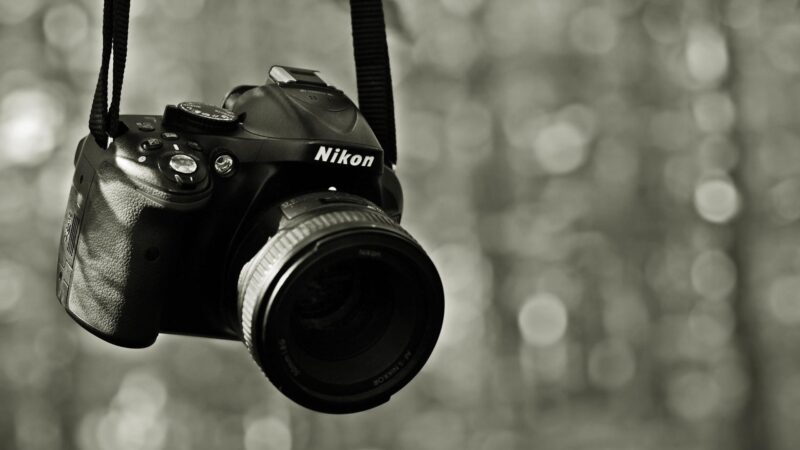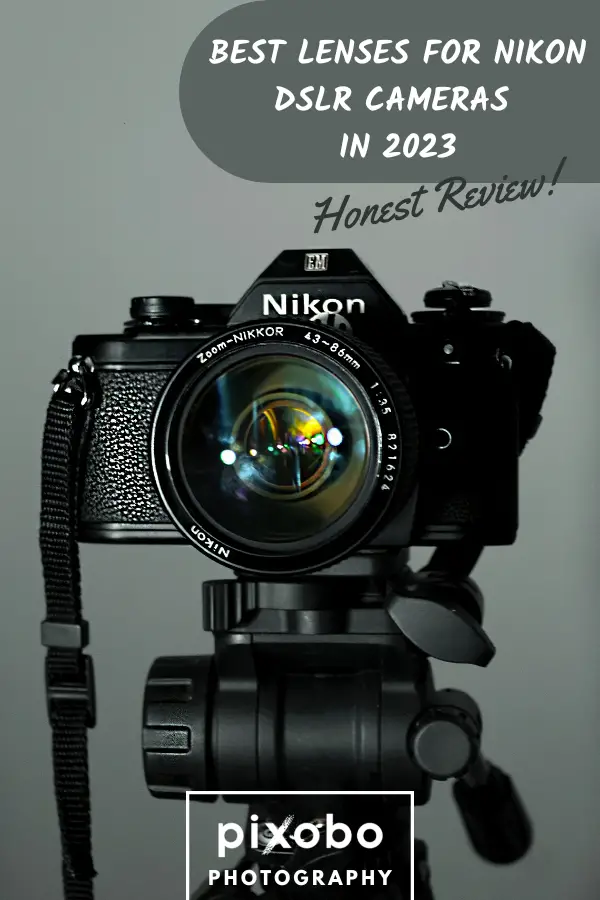Nikon DSLR cameras need the correct lens and the one that can give the best image quality. There are two types of Nikon lenses – the FX (full-frame) lenses and DX (APS-C) lenses. Both lenses can be used in DX and FX format cameras. However, using a DX lens on FX cameras has some limitations and reduces the image quality.
Nikon lenses also work differently, depending on the design and field of photography. Some variants from third-party lenses, such as Tamron and Sigma, work better than first-party lenses and are much cheaper. Nevertheless, they might not be able to produce the same image quality. With that, here are some best lenses for Nikon DSLRs in 2024.
Table of Content
Travel and Landscape Photography

1. Nikon 24-85mm F/3.5-4.5G ED VR AF-S
- Engineered for Nikon FX-format DSLRs
- Maximum Angle of View (DX-format): 61°, Minimum Angle of View (DX format): 18°50’, Maximum Angle of View (FX-format): 84°, Minimum Angle of View (FX-format): 28°30’.Focal Length Range : 24 to 85 millimeter, Minimum Focus Distance : 125 feet ( 038 meter)
- Nikon VR (Vibration Reduction) Image Stabilization
Released in June 2012, the Nikon 24-85mm F/3.5-4.5G ED VR AF-S is a consumer-grade lens designed for Nikon FX DSLR cameras. This mid-range lens replaced the discontinued Nikon 24-85mm f/3.5-4.5G IF-ED and is ideal for travel and landscape photography. It also now costs more than half its initial price.
Nikon 24-85mm f/3.5-4.5G lenses have an Internal Focusing, Silent Wave Motor (SWM), and an ED glass element. They also offer the same minimum focus distance of 0.38m (1.25 ft) and seven rounded diaphragm blades. Besides that, the 24-85mm VR has the edge over its predecessor and is packed with new features.
As the name suggests, the 24-85mm F/3.5-4.5G ED VR features Vibration Reduction (VR II), offering generous 4 stops of hand-holding stability. The optical design comprises 16 elements in 11 groups, including 3 aspherical elements. It also offers a slightly higher maximum magnification of 0.22x instead of 0.21x of its predecessor.
This versatile 24-85mm F/3.5-4.5G VR is 82 mm (3.23 inches) long and weighs 485 grams (1.07 lb), making it easy to carry in everyday photography. However, the resulting images can have some barrel distortion at their widest end, and extreme corners have noticeable chromatic aberration. Nevertheless, the overall performance is great.
2. Sigma 14-24mm f/2.8 DG HSM
- Ultra-wide-angle zoom lens
- Fast F2.8 maximum aperture
- Falls into Sigma's Art range of lenses
Released in February 2018, the Sigma 14-24mm f/2.8 DG HSM is a premium ultra-wide-angle zoom lens ideal for landscape photography. This third-party glass has been a notorious competitor of Canon and Nikon lenses of the same kind. But then, it is a sure winner regarding the price.
Compatible with Nikon full-frame DSLR cameras, the Sigma 14-24mm f/2.8 DG HSM comprises 17 elements in 11 groups. This includes three Fluorite Low Dispersion (FLD) elements, three Special Low Dispersion (SLD) elements, and three aspherical elements. But unlike the Nikon 24-85mm VR, this lens has no built-in image stabilization.
This Sigma 14-24mm f/2.8 DG has an impressive minimum focusing distance of 26 cm (10.24 inches), a maximum magnification of 0.18x, a Hyper Sonic Motor (HSM), full-time manual focusing, an optimized AF algorithm, as well as 9 rounded diaphragm blades.
Unfortunately, it has no zoom lock or filter thread, and it is a bit heavy at 1150 grams.
Like in most Sigma lenses, the company’s own Super Multi-Layer Coating.is applied to the body of the lens. This lens is dust and splash-resistant, has a rear gasket seal, and is easy to clean. It exhibits chromatic aberration but only in small amounts and is well-controlled. Generally speaking, this Sigma 14-24mm f/2.8 DG is an excellent option.
3. Sigma 18-35mm F1.8 Art DC HSM
- Designed specifically for APS-C sized sensors
- Internal focusing and zooming allows for more usability and functionality
- The 18-35mm is ideal for landscapes, portraits, still life, snap shots, casual, and close-ups
Announced in April 2013, the Sigma 18-35mm f/1.8 DC HSM Art is known for being the world’s first constant f/1.8 zoom lens for DSLRs. Aside from that, this wide-angle to standard zoom lens has impressive features but is being sold at a very competitive price. No wonder it won the Lens of the Year award at the Camera Grand Prix in the same year.
This professional-grade Sigma 18-35mm Art lens has a fast constant F1.8 maximum aperture. This allows travel and landscape photographers to shoot in low-light situations. Compared to f/2.8 or smaller aperture lenses, this revolutionary lens also produces a much shallower depth of field. Thus, putting the subject in sharper focus.
The optical design comprises 17 lens elements in 12 groups, including five special low dispersion (SLD) elements and four aspherical elements. Despite not having an image stabilizer, the fast shutter speeds in dark light due to the wide aperture are a good compensation. The minimum aperture is f/16, where the aperture remains constant.
The Sigma 18-35mm f/1.8 also sports 9 rounded diaphragm blades. It has a minimum focus distance of 0.28m (0.92ft) and a 0.23x maximum magnification. It is also great for controlling lateral chromatic aberration. The expected vignetting at its widest aperture is also well-controlled. To sum it up, this amazingly sharp lens is ideal for enthusiasts.
4. Nikon 28-300mm f/3.5-5.6G VR
- Versatile 107x zoom lens with ED glass and VR II image stabilization
- Optimized for edge to edge sharpness on both FX and DX-format
- Covers a wide range of focal lengths to get the best out of every subject. Minimum Focus Distance- 1.6 ft. (0.5m) throughout entire zoom range
With a zoom range of 28 to 300mm and integrated vibration reduction, the Nikon AF-S 28-300mm f/3.5-5.6G ED VR boasts a wide range. It is enhanced with several Nikon optical technology. The lens is equipped with the most recent version of VR II (vibration reduction) technology. This compensates for camera movement by increasing the shutter speed by about four stops.
Photographers may use specialty filters on the lens without fiddling with adapter rings since it has a 77mm filter thread. This is a normal filter size for professional-level lenses, unlike the Nikon 18-200mm lens.
Because of its internal focus (IF) mechanism and Silent Wave Motor, you may utilize manual focus even while your camera is in auto-focus mode. Moreover, it has two vibration reduction (VR) types, namely Normal and Active.
Normal VR overlooks slow and broad motions while compensating for rapid and minor hand tremors. Conversely, active VR strives to account for all movements and is better if you shoot from moving objects.
Portrait and Outdoor Photography

1. Nikon AF-S Nikkor 50mm f/1.8G
- Fast, upgraded f/1.8, compact FX format prime lens. The picture angle with 35 millimeter (135) format is 47 degree and the maximum reproduction ratio is 0.15X
- Focal length 50 millimeter, minimum focus distance 1.48 feet (0.45 meter)
- Newly developed optical system with aspherical lens element, exclusive Nikon silent wave motor (SWM)
Released in June 2011, the Nikon AF-S Nikkor 50mm f/1.8G replaced the Nikon 50 mm f/1.8D AF Nikkor. Although both of them are now phase-out, the newer and better version is still available online. Being one of the most popular Nikon lenses, this solid consumer-grade lens introduced new exciting features but came cheaply.
Like its predecessor, the Nikon AF-S 50mm f/1.8G has a close focus distance of .45 mm (1.47 ft), 7 rounded aperture blades, 0.15x maximum magnification, and a Super Integrated Coating (SIC) system. Nonetheless, it has a built-in Silent Wave Motor (SWM) that offers nearly quiet AF operation and applies to newer DSLRs.
The Nikon AF-S 50mm f/1.8G also has an upgraded optical design, comprising 7 elements in 6 groups. This includes 1 aspherical lens element, the first for any Nikon 50mm lens. This Nikon F-mount lens works well on FX (full-frame), and DX (crop sensor) DLSRs, wherein the 50mm focal length will equal 75mm.
This Nikon 50mm f/1.8G version also has a bigger 58mm filter thread instead of 52 mm and a rubber gasket on the metal mount to prevent dust from entering the lens. But then, it is still not weather sealed. It is also a bit bigger than the f/1.8D and 30 grams heavier at 185 grams. Despite being discontinued, this 50mm f/1.8G lens is still top-of-the-line.
2. Tamron SP 45mm f/1.8 Di VC USD
- Fast f/1.8 aperture;Minimum Focus Distance 11.42" (29 cm)
- Dynamic close focusing capability; Angle of View (diagonal): 51°21’
- VC (Vibration Compensation) system
Announced in September 2015, the Tamron SP 45mm f/1.8 Di VC USD is known for being the world’s first image-stabilized standard prime lens. Aimed at portrait enthusiasts and professionals, this affordable standard focal length prime lens can be used with professional Nikon full-frame DSLR cameras, as well as Canon and Sony.
This Tamron SP 45mm f/1.8 Di has a built-in (Vibration Compensation (VC) system. This is its biggest advantage over its direct competitors, Sony, Canon, and Sigma. This equivalent image stabilization can provide up to 3.5 stops of correction. It also has a minimum focus distance of 0.29m (0.95 ft) but without the depth of field markings.
This Tamron 45mm f/1.8 Di VC has 10 elements in 8 groups, including two aspherical elements and a low-dispersion (LD) glass element. As the name implies, it sports a USD (Ultrasonic Silent Drive) AF motor for fast and nearly quiet focusing. This prime lens has 9 rounded diaphragm blades and offers a 1:3.4 maximum magnification.
It is built with eBAND (Extended Bandwidth & Angular-Dependency), broadband anti-reflective (BBAR), and fluorine coatings. This Tamron prime lens has excellent built quality and is very solid. However, there could be some noticeable chromatic aberration (color fringing). Besides that, this 520-gram 45mm f/1.8 Di VC is a decent lens.
3. Sigma 50mm F1.4 Art DG HSM
- 50mm focal length, Lens not zoomable
- 75mm equivalent focal length on APS-C cameras, 80mm equivalent focal length on Canon APS-C cameras
- F1.4 maximum aperture; F16 minimum
Announced in April 2014, the Sigma 50mm F1.4 Art DG HSM is a professional-level camera lens ideal for portrait and wedding photography but with a hefty price tag. This fixed focal length third-party lens won the Best Product Category award in the 2015 EISA Awards and is significantly sharper than its first-party 50mm f/1.4 competitors.
Available for Nikon F DSLRs (and Canon EF), the Sigma 50mm F1.4 Art DG HSM is similar to its predecessor, the Sigma 50mm F1.4 EX DG HSM. This includes having 9 rounded diaphragm blades, a 77-mm filter thread, f/16 minimum aperture, a maximum 46.8º angle of view, and a hypersonic motor for quiet autofocus.
On the other hand, the Sigma 50mm F1.4 Art DG has a bigger maximum magnification at 0.18x, a shorter minimum focusing distance at 0.40m (15.7 inches), and a rotating focus ring. It is also constructed with 13 elements in 8 groups, including three Special Low Dispersion (SLD) glass elements and one molded glass aspherical element.
Measuring 9.9 cm (3.9 inches) long and weighing 815 grams (1.8 lbs), this lens is significantly longer and heavier than the old version. It also has no image stabilizer. Although this lens is built with a Thermally Stable Composite (TSC), it is not weather-sealed and has no rubber gasket. But overall, this Sigma 50mm F1.4 Art is a steal.
4. Nikon AF-S 70-200mm f/2.8E
- Minimum Focus Distance- 3.6 feet (1.1 meter)
- Diaphragm blades: 9. Format: FX/35 millimeter. Minimum Aperture: f/ 22
- Focus distance indicator- 1.1 am to infinity
In October 2016, Nikon AF-S NIKKOR 70-200mm f/2.8E FL ED VR became available. Wedding and event photographers will benefit from Nikon’s reduction of the minimum focus distance from 4.6 feet to 3.6 feet, as well as anyone who simply wants to get closer to their subject.
The VR image stabilization is still remarkable, especially after Nikon refined it. The new 70-200mm f/2.8 features four stops of effective shutter speed instead of 3.5 stops. Even at the frame’s edge, the focus plane is precise. With VR technology, handheld 1/40-second shots may be taken without blur.
At the center and at medium apertures, 70mm has good standard performance. Even at f/22, the results are excellent despite the onset of diffraction. The edges are great between f/5.6 and f/16 and once again outstanding at f/22. They are also quite fine at f/2.8 and f/4.
Additionally, this lens focuses exceptionally swiftly when it is in Spot AF mode. On the other hand, you’ll be astonished at how effectively your camera handles moving subjects if you set it to Continuous AF.
Macro Photography

1. Nikon AF FX Micro-NIKKOR 200mm f/4D IF-ED
- 200mm; F/4.0; Micro lens
- D-Series; Uses 62mm filter
- Lens not zoomable
Released in December 1993, the Nikon AF FX Micro-NIKKOR 200mm f/4D IF-ED is probably the best telephoto lens for macro photography that has ever been built. As a true macro lens, it has an amazing 1:1 reproduction ratio. Despite being listed as discontinued, this legendary prime macro lens continues to be sold online at a hefty price.
First, Nikon AF FX 200mm f/4D IF-ED has no focus motor. The Nikon lenses with a focus motor are the AF-S lenses. You can use only AF lenses with Nikon DSLR cameras with built-in AF motors, such as the D7000 and D1 to D5 series. This lens has no hood, but you can buy one separately.
Unlike the younger Nikon lenses, this iconic lens lacks image stabilization and has a non-removable tripod collar. Since it is an IF, it has an internal focus. Therefore, the front element does not rotate. This 1190-gram old-school lens has a strong metal body and a well-dampened rubber focus ring. It is not fully weather-sealed, though.
Built with 11 elements in 8 groups, this Nikon AF FX 200mm f/4D IF-ED includes two Extra-Low Dispersion (ED) elements and a Super Integrated Coat (SIC) element. It also has 9 rounded diaphragm blades and offers a minimum focus distance of 0.5m (1.6 ft). Regardless of its cons, this masterpiece produces super-sharp images in every corner.
2. Nikon AF-S VR Micro-NIKKOR 105mm f/2.8G IF-ED
- Designed for close-up and macro photography; versatile enough for virtually any photographic situation
- Maximum Angle of View (FX-format): 23°20'.Features new VR II vibration reduction technology, Focal Length : 105 mm, Minimum Focus Distance : 1.03 feet ( 0314 m)
- Nano-Crystal coat and ED glass elements that enhance overall image quality by further reducing flare and chromatic aberrations
Announced in February 2006, the Nikon AF-S VR Micro-NIKKOR 105mm f/2.8G IF-ED is another true macro lens with 1:1 macro magnification. As the name implies, it has the company’s VRII (Vibration Reduction) and SWM (Silent Wave Motor) systems. Interestingly, it is also the world’s first macro lens to use these technologies.
Aimed at professional macro photographers, the Nikon AF-S VR 105mm f/2.8G IF-ED comprises 14 elements in 12 groups. This includes one ED (Extra Low Dispersion) glass element and a Nano Crystal Coat-deposited lens element. The enhanced VR technology provides 3 stops of correction, ideal for extreme close-up photography.
This Nikon 105mm f/2.8G AF-S VR has 9 rounded diaphragm blades, a manual focus ring, a 62-mm filter thread, and allows a minimum focus distance of 1.0 ft. (0.314m). It is also compatible with Nikon AF-S teleconverters. As an added feature to reduce flare and ghosts, this lens is constructed using Super Integrated Coating (SIC) system.
Weighing 720 grams (1.58 lbs), this macro lens is great even for handheld macro photography and works perfectly on all equivalent Nikon FX and DX DSLR cameras. And although it is listed as discontinued since September 2021, this Nikon AF-S VR Micro-NIKKOR 105mm f/2.8G IF-ED is still available online for a very affordable price.
3. Sigma 180mm F2.8 EX APO DG HSM OS Macro
- Focusing distance of 47cm/18.5-Inch
- Equipped with Sigma's own propriety OS (Optical Stabilizer) system, this lens offers the use of shutter speeds approximately 4 stops slower than would otherwise be possible, enabling handheld close-up photography.
- This lens incorporates Sigma's floating inner focusing system. This minimizes aberrations which occur as shooting distances change, and enables stable rendering of the image from infinity to 1:1 magnification.
Released in July 2012, the Sigma 180mm F2.8 EX APO DG HSM OS Macro is the world’s first 180mm macro lens. Unlike Canon, Nikon does not have its own 180mm macro lens. Being a true macro lens, this third-party high-speed macro lens offers a magnification ratio of 1:1, making it ideal for macro (extreme close-up) photography.
The Sigma 180mm f2.8 macro lens comprises 19 elements in 14 groups, including 3 FLD (“F” Low Dispersion) glass elements, which offer the highest level of performance. There is also an inclusion of an efficient 4-stop optical image stabilization, which allows you to shoot handheld with greatly reduced camera shake or if you don’t have a tripod.
Also included are a 9-blade rounded diaphragm, internal focusing, and an 86-mm filter thread. As the name suggests, the Sigma 180mm f2.8 is equipped with a Hyper Sonic Motor (HSM) system for fast, quiet, and accurate focusing. The DG denotes that this macro lens is compatible with full-frame sensor DSLR cameras, especially Nikon.
The Sigma 180mm F2.8 EX APO DG HSM OS also offers a minimum focus distance of 47 cm (18.5 inches) and comes with a removable tripod ring mount and a round lens hood. There are no depth-of-field indicators, though. It is also quite bulky and heavy at 1,640 grams. But other than that, this Sigma 180mm f2.8 macro lens is a superb glass.
Wildlife and Sports Photography

1. Sigma 150-600mm F5-6.3 Sports DG OS HSM
- Maximum Aperture Range: f/3.5-6.3
- One SLD and Four FLD Elements
- Super Multi-Layer Coating
The Sigma 150-600mm F5-6.3 Sports DG OS HSM was released in September 2014, alongside the Sigma 50-600mm F5-6.3 DG OS HSM Contemporary. These zoom lenses have a lot of similarities, but the former is aimed at fast-action sports professional photographers, hence the name. It is also the enhanced version of the Contemporary version.
Sigma 150-600mm f/5-6.3 DG OS HSM lenses have an updated Optical Stabilizer (OS) with an accelerometer, a Hyper Sonic Motor system, 9 rounded diaphragm blades, and dual switchable autofocus modes. They also offer a diagonal angle of view at 16.4° – 4.1°, a minimum aperture range of f/5-22, and a maximum magnification of 0.20x.
Meanwhile, the Sigma 150-600mm f/5-6.3 DG OS HSM Sports has 24 elements in 16 groups compared to only 20 elements in 14 groups of the Contemporary edition. This includes two top-grade FLD (Fluorite Low Dispersion) glass elements rather than just one and three SLD (special low dispersion) glass elements instead of only two.
The Sigma 150-600mm Sports edition also has a shorter minimum focusing distance at 2.60 m (8.53 ft) instead of 2.80 m and a longer 105-mm filter thread rather than 95 mm only. Both Sigma 150-600mm lenses have weather-sealing, but the Sports version is extensively sealed throughout the barrel rather than around the lens mount only.
As expected, the Sigma 150-600mm Sports is significantly bulkier and heavier at 2860 grams (6.3 lbs). Its price is also around $1,000 higher than its sibling. Yes, you can also use the Contemporary for wildlife and sports photography. But if you have the budget and are serious about it, the Sports edition is worth spending for.
2. Nikon AF-S FX NIKKOR 200-400mm f/4G ED Vibration Reduction II
- 200-400mm f/4G AF-S super-telephoto zoom lens is perfect for sports and wildlife shooting; offers constant maximum aperture
- Nikon VR II (Vibration Reduction) Image Stabilization enables handheld shooting at up to 4 shutter speeds slower than would otherwise be possible
- Nano Crystal Coat further reduces ghosting and interior flare across a wide range of wavelengths
Nikon announced the AF-S FX NIKKOR 200-400mm f/4G ED Vibration Reduction II zoom lens back in April 2010. It is well-suited for wildlife and sports photography. This revised version of the 2003 AF-S 200-400mm f/4G IF-ED VR is designed for professionals in wildlife and sports photography who need exceptional image quality.
Like its predecessor, the 200-400mm f/4G ED VR II offers a minimum aperture of f/32, a 0.27x maximum magnification, and a minimum focus distance of 2.2 m (6.6 ft). They have 24 elements in 17 groups, 9 rounded diaphragm blades, a 55-mm filter thread, a Silent Wave Motor (SWM) system, and 4 Extra-low Dispersion (ED) elements.
Expectedly, this Nikon 200-400mm f/4G VR II has a Vibration Reduction but at up to 4 stops rather than 3 stops. The lens has a fourth VR mode, enabling users to shoot sharper images from a moving vehicle. A fourth focus mode called A/M (Auto-Priority Manual Mode) is also added to transition from AF to manual while shooting easily.
Aside from that, this optical masterpiece uses Nikon’s Nano Crystal Coat-deposited lens elements to reduce ghosting and flare, resulting in clearer images. The barrel is made of magnesium alloy, while the mount is metal. The 200-400mm f/4G VR II is very expensive and heavy at 3360 grams. Still, this lens is a superb choice.
3. Sigma 100-400mm f/5-6.3 DG OS HSM C
- Full Frame Lens with APS-C compatibility
- Compact size meets strong image quality
- Ideal Use: Travel photography, wildlife photography, nature photography and bird photography
Released in February 2017, the Sigma 100-400mm f/5-6.3 DG OS HSM C is a budget-friendly Contemporary lens ideal for general-purpose wildlife photography. Compatible with Nikon FX full-frame DSLR cameras, this Sigma zoom lens has impressive features and is dubbed the company’s first “Global Vision” entry.
This Sigma 100-400mm f/5-6.3 DG OS HSM Contemporary has a construction of 21 elements in 15 groups, including four SLD (Special Low Dispersion) glass elements. It also has the traditional but dependable ring-type HSM (Hyper Sonic Motor) system, Optical Image Stabilization (approx. at 4 stops), and an AF range limiter.
This Sigma lens allows a maximum magnification of 0.26x and a minimum shooting distance of 1.6 m (63 inches). A zoom lock switch and a non-rotating 67-mm filter thread are also at the front. This telephoto zoom incorporates a push/pull mechanism for the zoom ring, which can be rotated smoothly like the smaller focus ring.
Despite not being weather-sealed, Sigma claims this Contemporary lens to be dust and splashproof. It is constructed using a Thermally Stable Composite (TSC) and has a rubber gasket around the mount. There is no tripod collar option, though. But with its excellent performance and low price, this Sigma C lens is a sure thing.
As you might have noticed, some Nikon DSLR lenses are now phase-out. The same thing is also happening to some Nikon DSLR cameras. This is due to the increasing popularity of mirrorless cameras. But no need to worry, as some Nikon DSLR lenses also work on some Nikon mirrorless cameras. You will need the right adapter, though.















